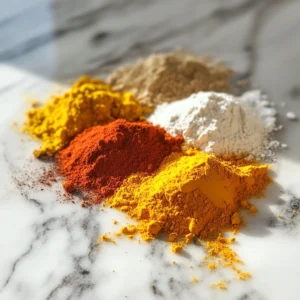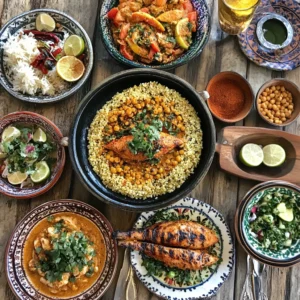In today’s culinary landscape, knowing how to combine spices is an essential skill for creating memorable dishes.
This guide will walk you through the art and science of spice pairing, offering insights into its historical roots, practical techniques, cultural nuances, and expert tips.
Whether you’re a novice cook or an experienced chef, understanding how to balance flavors and create harmonious spice blends will elevate your cooking to a new level.
Introduction
Spices have long been celebrated for their ability to transform simple ingredients into extraordinary dishes. By learning how to combine spices, you not only enhance the aroma and taste of your meals but also explore a world of culinary creativity. In this article, we will delve into:
- The importance of spice pairing: How the right combination can balance flavors and elevate your dishes.
- Historical evolution: A brief look at how spices have been used across centuries.
- Practical insights: Step-by-step guidelines for blending spices, along with expert tips and cultural perspectives.
For those interested in additional culinary tips, check out our guide on How to Sharpen a Knife.
Key concepts: spice pairing, flavor balance, culinary creativity, aroma, taste.
Understanding Spices and Their Role

Spices are much more than flavor enhancers; they are cultural symbols and culinary essentials that have influenced global cuisine for centuries. Here’s an in-depth look into their world:
- Definition and History:
- Spices are natural substances derived from plants—roots, bark, seeds, or fruits—used primarily for flavoring food.
- Their use dates back thousands of years, playing significant roles in trade, medicine, and religious rituals.
- Historical records indicate that ancient civilizations valued spices for their preservative qualities and unique aromatic properties.
- Cultural Significance:
- Different cultures have developed their own unique ways to use and combine spices.
- For example, Indian cuisine is renowned for its intricate spice blends like garam masala, while Middle Eastern dishes often incorporate cumin, coriander, and sumac.
- In French cooking, herbes de Provence exemplify how spices can create a subtle yet layered flavor profile.
- Impact on Modern Cuisine:
- Today, the art of spice pairing is critical for chefs who aim to balance sweet, sour, bitter, umami, and spicy notes.
- Experimenting with different spice combinations can lead to innovative recipes and reimagined classics.
For more insights into one of the world’s most prized spices, explore our article on Saffron Recipes: A Guide to Cook.
The Principles of Spice Pairing
Mastering the art of spice pairing involves understanding the different flavor profiles and how they interact. Here are some guiding principles:
- Flavor Profiles and Their Characteristics:
- Sweet: Often derived from spices like cinnamon or cardamom, adding warmth.
- Bitter: Spices such as turmeric or fenugreek offer subtle bitterness that balances rich flavors.
- Umami: Ingredients like mushroom powder or soy sauce contribute a deep savory essence.
- Spicy: Chili, paprika, and black pepper bring heat, which can brighten or intensify other flavors.
- Sour: Spices combined with citrus elements create a vibrant tanginess.
- Techniques for Blending:
- Start with a dominant spice that defines the dish.
- Build complexity gradually by adding supporting spices in small amounts.
- Balance intensity by using milder spices to tone down those with strong aromatic properties.
- Experiment with ratios to fine-tune the blend.
- Guiding Rules:
- Always consider the overall flavor profile of the dish.
- Ensure each spice complements the others, contributing to an aromatic harmony.
- Toast or grind spices fresh to release their full potential.
For further details on maintaining flavor balance, refer to our guide on The Ultimate Tajin Recipe: A Comprehensive Guide.
Cultural Perspectives on Spice Combinations
The way spices are combined varies greatly from one culture to another, offering endless inspiration for your own cooking experiments:
- Regional Approaches:
- French Cuisine: Emphasizes delicate blends like herbes de Provence for subtle, nuanced aromatic finesse.
- Indian Cuisine: Known for bold, vibrant spice mixtures such as garam masala and curry powders, balancing heat and sweetness.
- Middle Eastern Cuisine: Utilizes spices like cumin, coriander, and sumac to create rich, complex flavors.
- Asian Cuisine: Features a unique interplay between spicy, sweet, and sour elements, often with ginger and garlic.
- Traditional vs. Modern Techniques:
- Traditional Recipes: Rely on time-tested methods where spice pairing is passed down through generations.
- Modern Fusion: Chefs blend traditional spice combinations with innovative ingredients to create new culinary experiences.
For additional cultural insights, read our article on Discover Plymouth Cheese History.
The Science Behind Flavor Pairing
Understanding the science of flavor pairing can transform your approach to cooking. Here, we explore the chemical and sensory aspects that govern how spices interact:
- Chemical Composition of Spices:
- Essential oils and volatile compounds are the building blocks of spice aroma.
- These compounds interact to create the unique flavor profiles characteristic of each spice.
- For instance, cinnamaldehyde in cinnamon provides both its sweet flavor and a hint of spiciness.
- Sensory Perception:
- Our taste buds and olfactory sensors work together to create the overall perception of flavor.
- The aromatic profile of a spice can evoke memories and enhance the overall eating experience.
- Combining spices can create synergistic effects that elevate the dish’s taste.
- Practical Experiments:
- Test and Tweak: Experiment with small batches to find the perfect blend.
- Record Your Findings: Keep a culinary journal to note which combinations work best.
- Pair by Complement: Combine spices with similar chemical profiles for a harmonious blend.
Practical Guide to Combining Spices in Your Cooking

Here’s a step-by-step guide to help you master the art of combining spices:
- Selecting Your Spices:
- Choose a dominant spice to define your dish.
- Complement it with secondary spices that offer balanced aromatic qualities.
- Always opt for fresh, high-quality spices for optimal flavor.
- Preparing Your Spices:
- Toast whole spices lightly in a dry pan to release essential oils.
- Grind them into a fine powder if needed.
- Store in airtight containers to preserve their aroma.
- Blending Techniques:
- Start with small quantities to avoid overpowering the dish.
- Use a mortar and pestle or spice grinder to combine and release full flavor potential.
- Adjust ratios gradually while tasting the blend.
- Integrating the Blend:
- Add your spice blend early during cooking for deep infusion or as a finishing touch for a burst of aroma.
- Mix thoroughly to ensure even distribution.
- Dos and Don’ts:
- Do: Experiment with various combinations and document your successes.
- Do: Use complementary spices to achieve balance.
- Don’t: Overuse one spice; maintain a balanced flavor profile.
- Don’t: Overlook proper preparation methods like toasting and grinding.
For more kitchen tips, visit our article on Food in the Freezer: Unlock the Unbeatable Benefits for a Brighter Kitchen.
Spice Pairing in Different Cuisines

The art of spice pairing differs significantly between cuisines. Here are examples of regional approaches:
- Mediterranean Cuisine:
- Uses herbs such as oregano, thyme, and rosemary.
- Combines spices with olive oil, garlic, and lemon for a fresh, vibrant taste.
- Asian Cuisine:
- Often includes ginger, garlic, and star anise.
- Balances sweet, sour, and umami elements for layered flavor.
- African Cuisine:
- Showcases robust spice blends like cumin, coriander, and paprika.
- Focuses on bold, earthy flavors that reflect a rich culinary heritage.
- Latin American Cuisine:
- Relies on chili, cumin, and cilantro to deliver aromatic heat.
- Incorporates a mix of fresh ingredients and dried spice blends for energetic flavor.
For a taste of international cuisine, check out our Brazilian Lemonade: Refreshing Lime Drink Recipe.
Expert Tips and Tricks
Enhance your culinary skills with these expert insights on spice pairing:
- Professional Insights:
- Experimentation is key: Try unconventional combinations to discover new spice blends.
- Start simple: Build your confidence with basic spices before tackling complex mixes.
- Document your process: Keep a journal of your experiments to refine your technique.
- Creative Experimentation:
- Use seasonal spices, nutmeg and cloves in winter, basil and mint in summer.
- Pair spices with ingredients that offer complementary aromatic profiles.
- Develop your signature spice blend by combining traditional and modern elements.
- Presentation and Finishing Touches:
- Sprinkle a pinch of your homemade spice blend over finished dishes to add an extra layer of aroma.
- Enhance meats, vegetables, or even desserts with a light dusting of your blend.
For more creative ideas, read our article on Frozen Spinach Recipes: A Comprehensive Guide.
Troubleshooting Common Mistakes
Even experienced cooks can face challenges when combining spices. Here are common pitfalls and how to address them:
- Overpowering Flavors:
- Mistake: Using too much of a dominant spice can mask other flavors.
- Solution: Start with small amounts and adjust gradually; use complementary spices to balance intensity.
- Lack of Harmony:
- Mistake: Combining too many spices without a clear purpose may result in a muddled flavor profile.
- Solution: Establish a clear hierarchy—choose one or two main spices and build around them.
- Improper Preparation:
- Mistake: Not toasting or grinding spices properly can diminish their aroma.
- Solution: Ensure proper preparation (toasting, grinding, and storage) to unlock full flavor potential.
Conclusion and Key Takeaways
Mastering the art of combining spices is about balance, experimentation, and understanding the science behind flavors. Here are the key takeaways:
- Balanced Flavor Profiles: The right blend of spices transforms an ordinary dish into an extraordinary culinary experience.
- Cultural and Historical Insights: Embrace the rich heritage of spice pairing to inspire your culinary creations.
- Practical Techniques: Use the step-by-step guide to select, prepare, and blend your spices effectively.
- Continuous Experimentation: Keep testing and refining your combinations to develop your unique signature.
For further reading on spice pairing techniques, visit this article for additional expert advice.
Frequently Asked Questions
Below are some common questions about spice pairing along with succinct answers to help you on your culinary journey:
- What is the best ratio for mixing spices?
- Answer: Start with a dominant spice at around 50% of your blend, then add secondary spices gradually until you achieve the desired flavor profile.
- How can I tell if a spice blend is balanced?
- Answer: Taste the blend as you mix; it should offer a harmonious balance without any one spice overpowering the others.
- Which spices are best for a beginner’s recipe?
- Answer: Begin with familiar spices like cinnamon, paprika, and garlic; experiment with small quantities to understand how each contributes to the overall aroma.
- Can spice combinations be adjusted for dietary restrictions?
- Answer: Yes. Spice pairing is flexible—substitute or omit certain spices based on dietary needs without compromising flavor.
- How do storage conditions affect spice flavor?
- Answer: Spices stored in airtight containers away from light and heat retain their aromatic properties longer, ensuring a potent blend.
For more creative recipe ideas, check out our Triple Layer Brownie Recipe.
Bon appétit!

